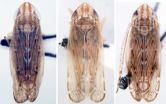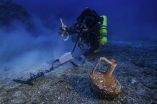INFORMATION:
The research was funded by the Canadian Institute for Advanced Research, the Canadian Foundation for Innovation and the U.S. National Science Foundation. Co-authors are Andrew Babbin at Princeton University and Eric Galbraith at Canada's McGill University.
For more information, contact Bianchi at 206-221-4402 or danbian@uw.edu.
Migrating animals' pee affects ocean chemistry
2014-10-09
(Press-News.org) The largest migration on the planet is the movement of small animals from the surface of the open ocean, where they feed on plants under cover of darkness, to the sunless depths where they hide from predators during the day.
University of Washington researchers have found that this regular migration helps shape our oceans. During the daylight hours below the surface the animals release ammonia, the equivalent of our urine, that turns out to play a significant role in marine chemistry, particularly in low-oxygen zones. Results are published online this week in the Proceedings of the National Academy of Sciences.
"I'm very fascinated by these massive migrations," said lead author Daniele Bianchi, a postdoctoral researcher in the UW School of Oceanography. "To me, it's exciting to think about the effects of animal behavior on a large scale in the ocean."
One might not think that peeing into the vastness of the oceans could have an effect. But the animals – which include tiny zooplankton, crustaceans such as krill, and fish such as lanternfish up to a few inches long – compensate for their small size with huge abundance throughout the world's oceans.
After a nighttime feast near the surface, these small creatures take a couple of hours to swim about 650 to 2,000 feet (200 to 600 meters) deep. Solid waste falls as pellets. The liquid waste is emitted more gradually.
In earlier work, Bianchi made the surprising finding that the animals spend most of their day in low-oxygen water. Marine bacteria consume oxygen as they decompose sinking dead material, creating low-oxygen zones a few hundred feet below the surface.
"The animals really seem to stop in low-oxygen regions, which is sort of puzzling," Bianchi said. Some speculated these zones might protect them from larger predators.
The earlier study also showed that animals actually contribute to these low-oxygen zones by using the little remaining oxygen to breathe.
Researchers next wondered about their other bodily functions.
For the new study, authors mined data from underwater sonar surveys to calculate how many animals are migrating to which depths, and where. Next they gauged the combined effect of their daytime digestion.
Results show that in certain parts of the ocean, ammonia released from animals drives a big part of the oxygen-free conversion of ammonium and other molecules to nitrogen gas, a key chemical transition.
"We still think bacteria do most of the job, but the effect of animals is enough to alter the rates of these reactions and maybe help explain some of the measurements," Bianchi said.
Inside low-oxygen zones, it's still mysterious how bacteria turn so much nitrogen-based ammonia into tight pairs of nitrogen atoms, like those found in air, which cannot be used by plants or animals. The conversion is important because it determines how much nitrogen-based fertilizer remains to support life in the world's oceans.
Researchers typically model low-oxygen zones using factors such as ocean currents, weather and bacterial growth. The new paper, Bianchi said, shows that diving animals, though more difficult to model, also play a role in marine chemistry.
The ocean's low-oxygen zones are projected to expand under climate change, as warmer waters hold less oxygen and decrease oxygen content below the surface. Understanding these zones is thus important for predicting what might happen to the oceans under climate change.
ELSE PRESS RELEASES FROM THIS DATE:
Penn Medicine's 'sepsis sniffer' generates faster sepsis care and suggests reduced mortality
2014-10-09
PHILADELPHIA - An automated early warning and response system for sepsis developed by Penn Medicine experts has resulted in a marked increase in sepsis identification and care, transfer to the ICU, and an indication of fewer deaths due to sepsis. A study assessing the tool is published online in the Journal of Hospital Medicine.
Sepsis is a potentially life-threatening complication of an infection; it can severely impair the body's organs, causing them to fail. There are as many as three million cases of severe sepsis and 750,000 resulting deaths in the United States ...
Manipulating memory with light
2014-10-09
Just look into the light: not quite, but researchers at the UC Davis Center for Neuroscience and Department of Psychology have used light to erase specific memories in mice, and proved a basic theory of how different parts of the brain work together to retrieve episodic memories.
Optogenetics, pioneered by Karl Diesseroth at Stanford University, is a new technique for manipulating and studying nerve cells using light. The techniques of optogenetics are rapidly becoming the standard method for investigating brain function.
Kazumasa Tanaka, Brian Wiltgen and colleagues ...
Space-based methane maps find largest US signal in Southwest
2014-10-09
ANN ARBOR—An unexpectedly high amount of the climate-changing gas methane, the main component of natural gas, is escaping from the Four Corners region in the U.S. Southwest, according to a new study by the University of Michigan and NASA.
The researchers mapped satellite data to uncover the nation's largest methane signal seen from space. They measured levels of the gas emitted from all sources, and found more than half a teragram per year coming from the area where Arizona, New Mexico, Colorado and Utah meet. That's about as much methane as the entire coal, oil, ...
Plant communities in Holy Land can cope with climate change of 'biblical' dimensions
2014-10-09
An international research team comprised of German, Israeli and American ecologists, including Dr. Claus Holzapfel, Dept. of Biological Sciences, Rutgers University-Newark, has conducted unique long-term experiments in Israel to test predictions of climate change, and has concluded that plant communities in the Holy Land can cope with climate change of "biblical" dimensions. Their findings appear in the current issue of Nature Communications at http://www.nature.com/ncomms/2014/141006/ncomms6102/pdf/ncomms6102.pdf.
When taking global climate change into account, many ...
NASA's Hubble maps the temperature and water vapor on an extreme exoplanet
2014-10-09
A team of scientists using NASA's Hubble Space Telescope has made the most detailed global map yet of the glow from a turbulent planet outside our solar system, revealing its secrets of air temperatures and water vapor.
Hubble observations show the exoplanet, called WASP-43b, is no place to call home. It is a world of extremes, where seething winds howl at the speed of sound from a 3,000-degree-Fahrenheit "day" side, hot enough to melt steel, to a pitch-black "night" side with plunging temperatures below 1,000 degrees Fahrenheit.
Astronomers have mapped the temperatures ...
DNA nano-foundries cast custom-shaped metal nanoparticles
2014-10-09
Researchers at the Wyss Institute for Biologically Inspired Engineering at Harvard University have unveiled a new method to form tiny 3D metal nanoparticles in prescribed shapes and dimensions using DNA, Nature's building block, as a construction mold.
The ability to mold inorganic nanoparticles out of materials such as gold and silver in precisely designed 3D shapes is a significant breakthrough that has the potential to advance laser technology, microscopy, solar cells, electronics, environmental testing, disease detection and more.
"We built tiny foundries made ...
Balancing birds and biofuels: Grasslands support more species than cornfields
2014-10-09
MADISON, Wis. – In Wisconsin, bioenergy is for the birds. Really.
In a study published today in the journal PLOS ONE, University of Wisconsin-Madison and Wisconsin Department of Natural Resources (DNR) scientists examined whether corn and perennial grassland fields in southern Wisconsin could provide both biomass for bioenergy production and bountiful bird habitat.
The research team found that where there are grasslands, there are birds. Grass-and-wildflower-dominated fields supported more than three times as many bird species as cornfields, including 10 imperiled ...
New leafhopper species named after University of Illinois entomologist
2014-10-09
Three new species of leafhoppers from China in the genus Futasujinus were recently identified during a review of leafhoppers in museum collections in China, the UK, and Illinois. One of them, Futasujinus dietrichi, was "named after Dr. Chris Dietrich, University of Illinois, USA, in recognition of his good work on leafhoppers." The new species are described in an article in Annals of the Entomological Society of America.
The other two species are Futasujinus truncatus and Futasujinus hastatus. Both species epithets allude to processes on their aedeagal shafts.
All three ...
Ebola research shows rapid control interventions key factor in preventing spread
2014-10-09
Tempe, Ariz. (Oct. 9, 2014) - New Ebola research demonstrates that quick and forceful implementation of control interventions are necessary to control outbreaks and avoid far worse scenarios.
Researchers analyzed up-to-date epidemiological data of Ebola cases in Nigeria as of Oct. 1, 2014, in order to estimate the case fatality rate, proportion of health care workers infected, transmission progression and impact of control interventions on the size of the epidemic.
"Rapid and forceful control measures are necessary as is demonstrated by the Nigerian success story. This ...
Stunning finds from ancient Greek shipwreck
2014-10-09
A Greek and international team of divers and archaeologists has retrieved stunning new finds from an ancient Greek ship that sank more than 2,000 years ago off the remote island of Antikythera. The rescued antiquities include tableware, ship components, and a giant bronze spear that would have belonged to a life-sized warrior statue.
The Antikythera wreck was first discovered in 1900 by sponge divers who were blown off course by a storm. They subsequently recovered a spectacular haul of ancient treasure including bronze and marble statues, jewellery, furniture, luxury ...




